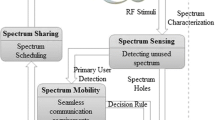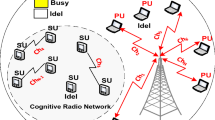Abstract
In the overlay medium access control (MAC) of cognitive radio networks, secondary user (SU) uses the spectrum portion which is assigned to primary user (PU), when PU is not using this spectrum at that time. In this article, a multiuser overlay MAC protocol is considered in which PUs and SUs are using time division multiple access and carrier sense multiple access (CSMA) MAC schemes, respectively. Firstly, new frame format and algorithm for the proposed MAC protocol are described, then the analytical modelling of this protocol is explained. In the SU network, Markov chain model along with the CSMA protocol is used for better utilization of the opportunity from the PU network (PUN). Channel utilization and probability of success are also derived and analyzed for this protocol with respect to idle time, collision (failure) time, various spectrum opportunities from PUN, number of SUs, and their fairness. This MAC scheme provides the optimal solution for channel utilization under a constraint on the probability of collisions. Numerical results are also provided to validate analysis of proposed MAC protocol and to investigate the performance behaviour of the optimal solution.















Similar content being viewed by others
References
Bayat, S., Louie, R. H., Vucetic, B., & Li, Y. (2013). Dynamic decentralised algorithms for cognitive radio relay networks with multiple primary and secondary users utilising matching theory. Transactions on Emerging Telecommunications Technologies, 24(5), 486–502.
Li, H., Grace, D., & Mitchell, P. (2010). Throughput analysis of non-persistent carrier sense multiple access combined with time division multiple access and its implication for cognitive radio. IET Communications, 4(11), 1356–1363.
Ansari, J., Zhang, X., & Mhnen, P. (2013). A decentralized MAC protocol for opportunistic spectrum access in cognitive wireless networks. Computer Communications, 36(13), 1399–1410.
Wang, Q., Ren, K., & Ning, P. (2011). Anti-jamming communication in cognitive radio networks with unknown channel statistics. In 19th IEEE international conference on network protocols (ICNP), (pp. 393–402).
Huang, H., Zhang, Z.-Y., Cheng, P., Huang, A.-P., & Qiu, P.-L. (2010). Cooperative spectrum sensing in cognitive radio systems with limited sensing ability. Journal of Zhejiang University SCIENCE C, 11, 175–186.
Fan, R., & Jiang, H. (2009). Channel sensing-order setting in cognitive radio networks: A two-user case. IEEE Transactions on Vehicular Technology, 58(9), 4997–5008.
Tan, L. T., & Le, L. B. (2012). Channel assignment with access contention resolution for cognitive radio networks. IEEE Transactions on Vehicular Technology, 61(6), 2808–2823.
Park, J., & van der Schaar, M. (2011). Cognitive mac protocols using memory for distributed spectrum sharing under limited spectrum sensing. IEEE Transactions on Communications, 59(9), 2627–2637.
Chen, Q., Wong, W.-C., Motani, M., & Liang, Y.-C. (2013). MAC protocol design and performance analysis for random access cognitive radio networks. IEEE Journal on Selected Areas in Communications, 31(11), 2289–2300.
Yu, H. (2013). Optimal channel sensing maximising sum rate in cognitive radio with multiple secondary links. Transactions on Emerging Telecommunications Technologies, 24(7–8), 777–784.
Maskery, M., Krishnamurthy, V., & Zhao, Q. (2009). Decentralized dynamic spectrum access for cognitive radios: cooperative design of a non-cooperative game. IEEE Transactions on Communications, 57(2), 459–469.
Su, H., & Zhang, X. (2007). Opportunistic mac protocols for cognitive radio based wireless networks. In Proceedings of 41st annual conference on information sciences and systems, 2007. CISS ’07 (pp. 363–368).
Jin, J., Xu, H., & Li, B. (2010). Multicast scheduling with cooperation and network coding in cognitive radio networks. In INFOCOM, 2010 Proceedings IEEE (pp. 1–9).
Cormio, C., & Chowdhury, K. R. (2009). A survey on MAC protocols for cognitive radio networks. Ad Hoc Networks, 7(7), 1315–1329.
Niyato, D., & Hossain, E. (2009). Cognitive radio for next-generation wireless networks: An approach to opportunistic channel selection in IEEE 802.11-based wireless mesh. IEEE Wireless Communications, 16(1), 46–54.
Li, Y., Jayaweera, S., Bkassiny, M., & Ghosh, C. (2014). Learning-aided sub-band selection algorithms for spectrum sensing in wide-band cognitive radios. IEEE Transactions on Wireless Communications, 13(4), 2012–2024.
Bae, Y. H., Alfa, A., & Choi, B. D. (2010). Performance analysis of modified ieee 802.11-based cognitive radio networks. IEEE Communications Letters, 14(10), 975–977.
Dang, D. N. M., Hong, C. S., Lee, S., & Huh, E.-N. (2014). An efficient and reliable MAC in VANETs. IEEE Communications Letters, 18(4), 616–619.
Zhang, L., Liu, Z., Zou, R., Guo, J., & Liu, Y. (2014). A scalable CSMA and self-organizing TDMA MAC for IEEE 802.11 p/1609.x in VANETs. Wireless Personal Communications, 74(4), 1197–1212.
De Domenico, A., Strinati, E., & Di Benedetto, M. (2012). A survey on MAC strategies for cognitive radio networks. IEEE Communications Surveys Tutorials, 14(1), 21–44.
Sengupta, S., Hong, K., Chandramouli, R., & Subbalakshmi, K. (2011). SpiderRadio: A cognitive radio network with commodity hardware and open source software. IEEE Communications Magazine, 49(3), 101–109.
Wong, P., Yin, D., & Lee, T. (2011). Performance analysis of markov modulated 1-persistent CSMA/CA protocols with exponential backoff scheduling. Wireless Networks, 17(8), 1763–1774.
Chong, J. W., Sung, Y., & Sung, D. K. (2009). RawPEACH: Multiband CSMA/CA-based cognitive radio networks. Journal of Communications and Networks, 11(2), 175–186.
Hossain, L. L. (2008). OSA-MAC: A mac protocol for opportunistic spectrum access in cognitive radio networks. In IEEE wireless communications and networking conference (WCNC), p. 142630.
Huang, S., Liu, X., & Ding, Z. (2009). Optimal sensing-transmission structure for dynamic spectrum access. In IEEE INFOCOM, pp. 2295–2303.
Huang, S., Liu, X., & Ding, Z. (2011). Decentralized cognitive radio control based on inference from primary link control information. IEEE Journal on Selected Areas in Communications, 29(2), 394–406.
Bertsekas, D., & Gallager, R. (1987). Multiaccess communication. In P. Janzow & B. M. de Leon (Eds.), Data networks (2nd ed., pp. 271–362). Englewood Cliffs, NJ: Prentice Hall.
Zhang, X., & S. H, (2011). CREAM-MAC: Cognitive radio-enabled multi-channel MAC protocol over dynamic spectrum access networks. IEEE Journal on Selected Topics in Signal Processing, 5(1), 110–123.
Saurabh Mittal, A. M. (2012). Comparative analysis of IEEE 802.11 DCF. International Journal of Research in IT & Management, 2(2), 726–740.
Bianchi, G. (2000). Introduction to performance analysis of the IEEE 802.11 DCF. http://www.mathcs.emory.edu/~cheung/Courses/558/Syllabus/00/802.11/int/ro.html
Zhai, H., Kwon, Y., & Fang, Y. (2004). Performance analysis of IEEE 802.11 MAC protocols in wireless LANs: Research articles. Wireless Communications and Mobile Computing, 4(8), 917–931.
Bianchi, G. (2000). Performance analysis of the ieee 802.11 distributed coordination function. IEEE Journal on Selected Areas in Communications, 18(3), 535–547.
Massey, J., & Mathys, P. (2006). The collision channel without feedback. IEEE Transactions on Information Theory, 31(2), 192–204.
D’Itri, S., & McHenry, M. A. (2008). Dynamic spectrum access moves to the forefront, defense electronics magazine. http://defenseelectronicsmag.com/military-defense-electronics/dynamic-spectrum-access-moves-forefront
Author information
Authors and Affiliations
Corresponding author
Rights and permissions
About this article
Cite this article
Chouhan, L., Trivedi, A. Performance study of a CSMA based multiuser MAC protocol for cognitive radio networks: analysis of channel utilization and opportunity perspective. Wireless Netw 22, 33–47 (2016). https://doi.org/10.1007/s11276-015-0947-7
Published:
Issue Date:
DOI: https://doi.org/10.1007/s11276-015-0947-7




